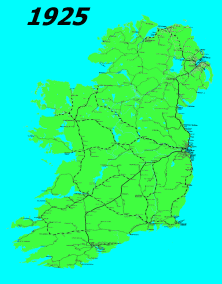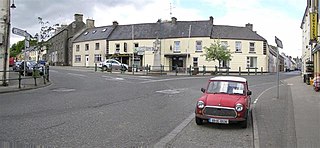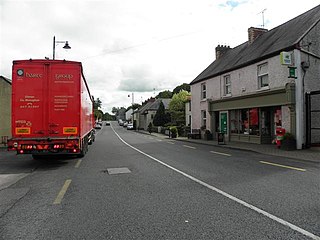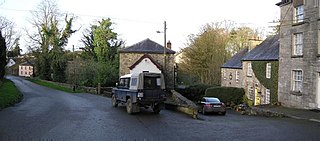
County Monaghan is a county in Ireland. It is in the province of Ulster and is part of Border strategic planning area of the Northern and Western Region. It is named after the town of Monaghan. Monaghan County Council is the local authority for the county. The population of the county was 65,288 according to the 2022 census.

Clones is a small town in the west of County Monaghan in Ireland. The area is part of the Border Region in the Republic of Ireland, earmarked for economic development by the Irish Government due to its currently below-average economic situation. The town was badly hit economically by the Partition of Ireland in 1921 because of its location on the border with County Fermanagh in Northern Ireland. The creation of the Irish border deprived it of access to a large part of its economic hinterland for many years. The town had a population of 1,680 at the 2016 census. The town is in a civil parish of the same name.

Monaghan is the county town of County Monaghan, Ireland. It also provides the name of its civil parish and Monaghan barony.

The history of rail transport in Ireland began only a decade later than that of Great Britain. By its peak in 1920, Ireland had 3,500 route miles (5,630 km). The current status is less than half that amount, with a large unserviced area around the border area between Northern Ireland and the Republic of Ireland.

Cavan is the county town of County Cavan in Ireland. The town lies in Ulster, near the border with County Fermanagh in Northern Ireland. The town is bypassed by the main N3 road that links Dublin with Enniskillen, Ballyshannon and Donegal Town.

Bundoran is a town in County Donegal, Ireland. The town is located near the N15 road near Ballyshannon, and is the most southerly town in Donegal. The town is a tourist seaside resort, and tourism has been at the heart of the local economy since the 18th century. Bundoran is a surfing destination and was listed by National Geographic magazine in 2012 as one of the world's top 20 surf towns.

The Ulster Transport Authority (UTA) ran rail and bus transport in Northern Ireland that operated from 1948 until 1967.

The Republic of Ireland–United Kingdom border, sometimes referred to as the Irish border or British–Irish border, runs for 499 km (310 mi) from Lough Foyle in the north-west of Ireland to Carlingford Lough in the north-east, separating the Republic of Ireland from Northern Ireland.

Pettigo, also spelt Pettigoe, is a small village and townland on the border of County Donegal, Republic of Ireland, and County Fermanagh, Northern Ireland. It is bisected by the Termon River which is part of the border between the Republic of Ireland and Northern Ireland.

The Great Northern Railway (Ireland) (GNR(I) or GNRI) was an Irish gauge (1,600 mm (5 ft 3 in)) railway company in Ireland. It was formed in 1876 by a merger of the Irish North Western Railway (INW), Northern Railway of Ireland, and Ulster Railway. The governments of Ireland and Northern Ireland jointly nationalised the company in 1953, and the company was liquidated in 1958: assets were split on national lines between the Ulster Transport Authority and Córas Iompair Éireann.

Cullaville or Culloville (from Irish Baile Mhic Cullach, meaning 'MacCullach's townland' or McCulloch's ville or town is a small village and townland near Crossmaglen in County Armagh, Northern Ireland. It is the southernmost settlement in the county and one of the southernmost in Northern Ireland, straddling the Irish border. In the 2001 Census it had a population of 400 people. The village is on a busy crossroads on the main Dundalk to Castleblaney road ; three of the roads lead across the border and the fourth leads to Crossmaglen.

InterCity is the brand name given to rail services operated by Iarnród Éireann that run between Dublin and other major cities in Ireland. InterCity branding is also used in other European countries by unaffiliated organizations.

Armagh railway station was a railway station that served Armagh in County Armagh, Northern Ireland.

Smithborough or Smithboro is a village in County Monaghan, Ireland. It is within the townlands of Mullaghduff and Mullaghbrack. It is roughly midway between Monaghan Town and Clones on the N54. Nearby villages within 6–7 km are Threemilehouse, Scotstown, Ballinode, and Newbliss all within County Monaghan and Roslea in County Fermanagh. The local football team is Éire Óg, who wear blue with a gold band.

Great Victoria Street was a railway station that served the city centre of Belfast, Northern Ireland. It was one of two main stations in the city, along with Lanyon Place, and was nearest to the city centre. The station was situated beside Great Victoria Street and shared a site with the Europa Buscentre, Belfast's former main bus station. The railway and bus stations were replaced by the adjacent Belfast Grand Central station with the official opening on 13 October 2024. Great Victoria Street railway station closed permanently on 10 May 2024, with a bus transfer service operating until rail services commenced from Belfast Grand Central, with a service to Dublin at 8:05 a.m. on 13 October 2024. Europa Buscentre closed permanently on 7 September 2024, with bus services immediately transferring to the new station, commencing with a service to Dublin at 5 a.m. on 8 September 2024.
The Londonderry and Enniskillen Railway (L&ER) was an Irish gauge railway in Ireland.

Glaslough is a village and townland in the north of County Monaghan, Ireland, on the R185 regional road 3 km (2 mi) south of the border with Northern Ireland and 10 km (6 mi) northeast of Monaghan town. Glaslough won the Irish Tidy Towns Competition in 1978 and again in 2019.

Clones railway station was a station on the Great Northern Railway (Ireland) that served the town of Clones, County Monaghan in the Ireland.

Monaghan railway station was on the Ulster Railway designed by Sir John Macneil located in the Republic of Ireland.
The Newry and Armagh Railway, initially the Newry and Enniskillen Railway, was opened in 1864 and ran until 1879.


















